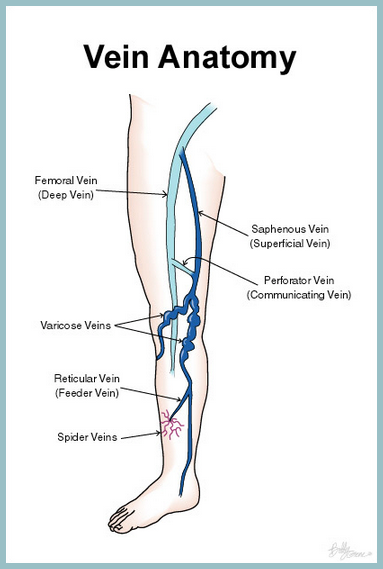Varicose Veins
We believe it’s in your best interest to have an understanding of varicose veins and the newest treatments available before undergoing treatment. The following overview provides information on varicose veins in an easy-to-understand question and answer format.
What are varicose veins?
Varicose veins are diseased blood vessels that have become permanently dilated (enlarged) and can no longer carry blood back to the heart efficiently. As the dilated veins begin to leak, oxygen-poor blood pools in the varicose veins and waste products accumulate in the legs. Untreated varicose veins can cause aching, heaviness and swelling, and can progress to a more serious form of venous disease called chronic venous insufficiency (CVI).

What causes varicose veins?
There are numerous causes. The most common are heredity, pregnancy, estrogen medications, prolonged standing or sitting, sedentary lifestyle and injury to the legs.
Can varicose veins affect my health in a negative way?
Yes, absolutely. Varicose veins are not merely a cosmetic issue. If not treated, varicose veins can lead to chronic venous insufficiency (CVI), a more serious condition. CVI is a progressive disease, which can cause pain, swelling, blood clots and leg ulcers. In fact, approximately 70 percent of leg ulcers are due to CVI.
Furthermore, blood clots that originate in the legs and travel to the lungs claim more lives than breast cancer, AIDS and car accidents combined (see www.preventdvt.org). Since blood clots can arise in varicose veins and move into deep circulation, eliminating the diseased varicose veins can help prevent dangerous clots and restore proper circulation.
Fortunately, by receiving timely treatment, you can prevent the progression to CVI. Because varicose veins can now be eliminated quickly and easily with an in-office procedure, there really is no reason to delay treatment.
How can I get checked for CVI?
The first step is to perform an imaging test called a venous duplex scan. This scan creates a “map” of your venous circulation and pinpoints the location of damaged veins. This important test is quick, painless, noninvasive and is covered by Medicare and most insurance plans. Our office is staffed with ARDMS-certified vascular technicians who have special expertise in performing venous studies. Armed with this information, we can develop a treatment plan to best address your specific situation.
Don’t I need my veins? What happens to my circulation if I get rid of them?
- Varicose veins are diseased and defective veins that have already lost their function. They are like “leaks,” which cause the legs to congest with toxins, as well as fill with oxygen-poor blood. Getting rid of them is not harmful. In fact, the circulation is improved because the numerous healthy veins can now do their job, without being counteracted by the leaking varicose veins. After treatment, legs often feel lighter and more energetic. Leg heaviness, aching, restlessness and cramping are also frequently alleviated. Even leg ulcers often heal quickly after treatment because of the improved venous return.
Varicose veins are like a traffic jam in the legs. Treatment allows us to correct this situation by rerouting traffic to the numerous, stronger, healthier veins.
How are varicose veins treated?
- Varicose veins can be treated by several minimally invasive procedures, without the pain or downtime of invasive surgery. Treatments are covered by many insurance plans.
Which treatment you will require depends on the location of your vein problem. Here is a list of some of the advanced treatments we use to address vein problems.
Endovenous laser treatment
Endovenous laser treatment is minimally invasive and requires little-to-no recovery time. This treatment addresses diseased internal saphenous veins, which may be the root of unsightly and unhealthy varicose veins.
Learn more about endovenous laser treatment
Ultrasound-guided sclerotherapy
Ultrasound-guided sclerotherapy is a versatile treatment that can be used for all sizes of varicose veins. Ultrasound-guided sclerotherapy is noninvasive, cost-effective and requires little-to-no recovery time. Patients are able to go for a walk immediately after their procedure.
Learn more about ultrasound-guided sclerotherapy
Microphlebectomy
Microphlebectomy is a procedure in which even the largest varicose veins can be removed through tiny “pokes” in the skin. The pokes are so small that no stitches are required and patients are back to walking the same day. Microphlebectomy is performed in the office, and the cosmetic results are typically excellent.
Learn more about microphlebectomy
Ready to take the first step toward better circulation? Schedule your appointment today — 480-844-VEIN (8346).